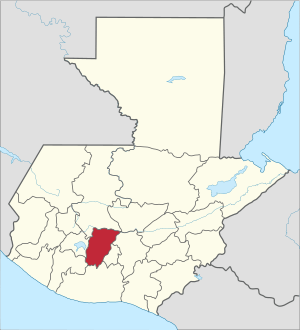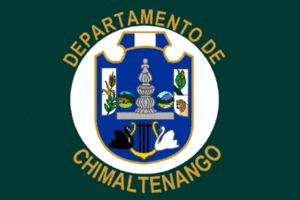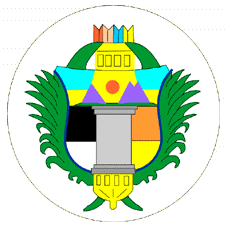Chimaltenango Department facts for kids
Chimaltenango is a special area in Guatemala called a department. Think of it like a state or a big county. Its main city, which is also its capital, is also called Chimaltenango. This department is known for its beautiful landscapes and rich history.
Contents
What is Chimaltenango?
Chimaltenango is one of Guatemala's 22 departments. It is located in the central highlands of the country. This area is famous for its cool climate and green mountains. Many people live here, and they have a strong connection to their ancient Mayan roots.
Where is Chimaltenango Located?
The Chimaltenango Department is in the central part of Guatemala. It is surrounded by other departments. To the north, you'll find El Quiché. To the east are Guatemala and Sacatepéquez. To the south, it borders Escuintla and Suchitepéquez. Finally, to the west, it touches Sololá and Totonicapán. This central location makes it an important part of the country.
How Big is Chimaltenango?
Chimaltenango covers an area of about 1,979 square kilometers (about 764 square miles). This makes it one of the smaller departments in Guatemala. However, it is home to many people. The population is quite large for its size.
A Look at Chimaltenango's History
The history of Chimaltenango is very old and interesting. It goes back thousands of years. The area was once part of the ancient Mayan civilization.
Ancient Mayan Roots
Before the Spanish arrived, the land of Chimaltenango was home to the Kaqchikel Maya people. They built important cities and developed advanced systems. These included writing, mathematics, and astronomy. Their capital city was Iximche. It was located near what is now Tecpán Guatemala. Iximche was a powerful city. It played a big role in the region.
Spanish Arrival and Colonial Times
In the 1520s, the Spanish conquistadors arrived in Guatemala. They conquered the Kaqchikel people. The Spanish then established new towns and systems. Chimaltenango became an important area for farming. They grew crops like wheat and corn. The Spanish also built churches and introduced new ways of life.
Chimaltenango in Modern Times
After Guatemala gained independence from Spain in 1821, Chimaltenango continued to grow. It became an official department in 1839. Today, it is a mix of old traditions and new developments. Many people still speak the Kaqchikel language. They also keep their cultural practices alive.
People and Culture of Chimaltenango
The people of Chimaltenango are mostly indigenous Kaqchikel Maya. They are known for their strong cultural identity.
Traditional Clothing and Crafts
One of the most colorful parts of Chimaltenango's culture is its traditional clothing. Women often wear beautiful huipiles. These are blouses with intricate designs. They also wear cortes, which are wrap-around skirts. Each village has its own unique patterns and colors. Men sometimes wear traditional woven shirts and pants. Local artisans also create amazing crafts. These include pottery, textiles, and wood carvings.
Festivals and Celebrations
Chimaltenango is a place of many vibrant festivals. These often mix ancient Mayan beliefs with Catholic traditions. The patron saint's day of each municipality is a big event. People celebrate with music, dancing, parades, and special foods. The most famous festival is the one for Saint Anne. It takes place in the capital city of Chimaltenango.
Food and Flavors
The food in Chimaltenango is delicious and hearty. It often uses local ingredients like corn, beans, and vegetables. Popular dishes include pepián, a rich stew. Another favorite is jocón, a green chicken stew. Tamales and atol (a warm corn drink) are also common. These foods are an important part of family gatherings and celebrations.
Exploring the Municipalities
The Chimaltenango Department is divided into several smaller areas called municipalities. Each municipality has its own capital town. These towns are important centers for local life.
- Acatenango
- Chimaltenango (the capital city of the department)
- El Tejar
- Parramos
- Patzicía
- Patzún
- Pochuta
- San Andrés Itzapa
- San José Poaquil
- San Juan Comalapa
- San Martín Jilotepeque
- Santa Apolonia
- Santa Cruz Balanyá
- Tecpán Guatemala
- Yepocapa
- Zaragoza
What Makes Each Municipality Special?
Each municipality in Chimaltenango has its own unique charm. For example, Tecpán Guatemala is famous for its historical importance. It was once the site of the Kaqchikel capital, Iximche. Patzún is known for its beautiful textiles. San Juan Comalapa is famous for its many talented painters. These artists create vibrant murals and paintings.
Natural Wonders and Landmarks
Chimaltenango is a beautiful department with stunning natural scenery. It also has important historical sites.
Volcanoes and Mountains
The department is home to several impressive volcanoes. The most famous is Volcán de Fuego (Fire Volcano). It is one of the most active volcanoes in Guatemala. While beautiful, it is also closely monitored for safety. Another notable peak is Volcán Acatenango. It is a twin volcano to Fuego. These volcanoes offer incredible views and are popular for hiking, though safety is always a priority.
Historical Sites to Visit
The most important historical site in Chimaltenango is Iximche. This ancient Mayan city was the capital of the Kaqchikel kingdom. Today, you can visit its ruins. You can see ancient pyramids, plazas, and ball courts. It's a great place to learn about Mayan history. There are also many colonial-era churches throughout the department. These show the Spanish influence on the region.
Economy and Daily Life
The economy of Chimaltenango mainly relies on farming. Many people work in agriculture.
Farming and Agriculture
The rich volcanic soil in Chimaltenango is perfect for growing crops. Farmers grow corn, beans, potatoes, and various vegetables. Coffee is also an important crop. It is grown in the higher, cooler areas. Farming provides food for the local people and also for export.
Other Industries
Besides farming, there are other smaller industries. These include textile production and handicrafts. Tourism is also growing. Visitors come to see the volcanoes, historical sites, and cultural festivals. These activities help support the local economy.
See also
 In Spanish: Departamento de Chimaltenango para niños
In Spanish: Departamento de Chimaltenango para niños




